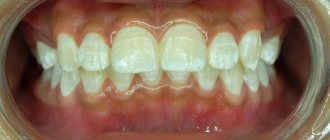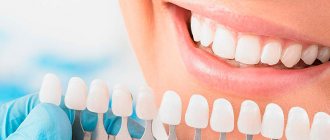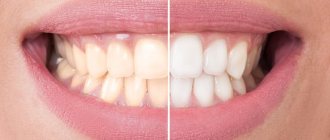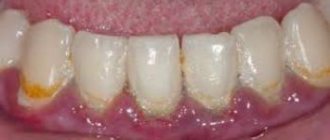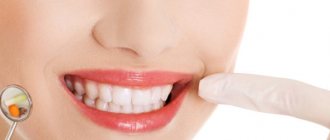A snow-white smile always speaks of a person’s health. It makes a person attractive, you want to communicate with him. But sometimes there are situations where some defects appear on the teeth, such as yellow spots. This is often a sign of a dental problem. Moreover, the defect can appear at any age, both in a child and an adult. This circumstance should alert you and you should go for an examination to the dentist. He will conduct a comprehensive diagnosis, determine the causes of the pathology, and prescribe treatment.
Chromogenic components (food, drinks, other products)
The food we eat and other substances we use contain coloring agents (coffee, tea, cola, wine, tobacco, etc.) that can cause yellow, brown or bright orange spots to appear on the skin. teeth In most cases, the discoloration of teeth is generalized, which means that stains tend to form with equal success both on the entire surface of the tooth and in individual areas. If stains appear, it is better to make an appointment with an inexpensive dentist near your place of residence.
Medical stain removal
To eliminate yellowness of enamel in dentistry, there are many methods used routinely. Before professional removal of yellow stains begins, an examination of the oral cavity is carried out to identify the true cause of the pathology. Patients are often recommended to have their teeth professionally cleaned twice a year.
There are several methods of hygienic treatment:
- laser exposure effectively removes tartar and plaque, splitting them into small particles;
- ultrasonic exposure destroys enamel layers due to frequency vibrations;
- treatment with gel and activator lamp is effective due to the content of hydrogen peroxide in its composition.
If pigmentation is associated with the removal of a nerve or clouding of the filling, various agents are introduced into the dental canal to help whiten the teeth from the inside.
There are times when it is impossible to eliminate yellowness. In this situation, the patient is offered to use veneers or lumineers. Onlays are made according to individual parameters of dental impressions. Since the thickness of such devices is minimal, they are completely invisible on the teeth.
Tooth decay
In the early stages of tooth decay, white spots or spots appear on the tooth enamel. The affected areas lose their natural shine and become dull. A thorough examination reveals the presence of damage to the enamel. If the process of tooth decay progresses, the affected area becomes brown or black, it is necessary to diagnose dental treatment. The damage is initially noticeable as a small dark spot or spots that gradually increase in size (over several months to several years) and often lead to actual tooth decay.
White spots on a child's teeth
- Fluorosis
Sometimes an excess of beneficial minerals is harmful - if too much fluoride (fluoride compounds) enters the body, there is a risk of developing fluorosis. In the period from 1 month to 7-8 years, excess fluoride ions disrupts the processes of enamel mineralization. This is why light marks may appear on children's teeth, which will gradually darken and eventually turn into brown or brown spots. - Enamel hypoplasia
Underdevelopment of enamel that causes white spots on primary teeth, although the condition can also affect permanent teeth. The causes of hypoplasia are illnesses that the mother suffered during pregnancy, birth injuries, and mineral metabolism disorders in the first months of the child’s life. The enamel, in addition to spots that can be either light or brownish, is covered with grooves and depressions where plaque actively accumulates, which causes caries, which, due to a lack of hard tissue, develops even faster than usual. This is why enamel hypoplasia in children requires immediate treatment. - Braces
If an orthodontist identifies bite defects, he prescribes correction with braces. Most often they are worn by teenagers - and although there are already aligners, many parents and doctors find it easier to control the progress of treatment with braces. This is an effective and reliable way to correct a bite, but it has a significant drawback - difficulties with nutrition and oral hygiene. Food particles get stuck in the arches and fastenings, which is why the teenager often refuses healthy products containing substances necessary for enamel. On the other hand, since braces are a permanent orthodontic system, teeth cleaning becomes seriously complicated and requires special brushes, brushes, and an irrigator. Due to poor nutrition and hygiene after braces are removed, white spots may be found on a child’s teeth. - Caries
This is a common cause in both children and adults - a white spot is most often the first sign of carious enamel damage. At the initial stage, caries often looks not like black or brown, but like a whitish spot - and many adults do not attach any importance to this. However, it is at the spot stage that caries, both for children and adults, is treated most effectively - and even without a drill. For example, Icon technology, developed in Germany, allows, using a polymer solution that hardens under the influence of ultraviolet light, to destroy cariogenic bacteria, seal the carious stain and restore the density of the enamel.
Fluorosis due to excess fluoride
Fluorosis is a chronic disease that attacks tooth enamel. It develops over years under prolonged exposure to fluoride in the body. The disease manifests itself in the form of multiple pigment spots on the enamel, more often on the upper teeth. Signs of fluorosis:
- strokes: strokes or thin stripes appear on the upper and lower incisors; they can be blurred or clearly defined;
- spots: they have a light shade and a vague shape, smoothly turning into the natural shade of the enamel;
- speckled: darkening has clear boundaries, a matte tint, can be in the form of spots or dots, there are specks with dark depressions;
- erosion: destruction of enamel, significant depressions up to dentin exposure;
- destruction: severe destruction of enamel and dentin, the shape of the tooth crown is distorted, teeth can break off.
Stages of the disease: mild, moderate, moderate and severe. At the mild stage, pigmentation is barely noticeable and affects no more than ¼ of the teeth. The moderate stage is characterized by more noticeable darkening on half of the teeth. With medium age, dark spots appear, the enamel becomes thin and sensitive. At a severe stage, erosion is added to the darkening of the enamel, the crowns are deformed, and up to ¾ of the teeth are affected.
One of the main reasons for the development of dental fluorosis is excess fluoride in drinking water. We can talk about an excess when the amount of this substance exceeds 2.5 mg/l (with the norm being 1-1.5 mg/l). In addition to water, we get fluoride from:
- walnuts,
- sea fish,
- fruits (grapes, strawberries, peaches),
- vegetables (onions, garlic, carrots),
- toothpastes and rinses containing fluoride,
- medications and dietary supplements,
- polluted air.
It is important to distinguish fluorosis from caries. The reasons for the development of these diseases are opposite: caries is the result of a lack of fluoride, fluorosis is the result of an excess. And yet they are similar in appearance. How to distinguish them? Caries affects individual teeth and their areas, fluorosis manifests itself evenly on all dental units. Spots with fluorosis can be white, yellow, and brown at the same time. Caries appears as a continuous, monochromatic spot. Fluorosis occurs on any surface of the tooth, and caries occurs only in the chewing and interdental areas.
Elimination at home
As many years of research have shown, only plaque caused by food can be eliminated at home. If you regularly use high-quality toothpastes and toothbrushes, mouthwashes, and use whitening pastes once a week, you can achieve good results. Pharmacies also sell special kits - a silicone tray and a gel, which contains hydrogen peroxide or active enzymes that chemically destroy the plaque film.
Stomatitis is a common dental disease. Various medications are used to treat it. One of these is Vinylin. This time-tested product has antimicrobial and restorative properties. Read more in the article: “vinyline for stomatitis - should you expect an effect.”
The chronic yellowing of a heavy smoker and coffee drinker is almost impossible to eliminate without the help of dentists. Having penetrated into the deep layers of enamel, the dyes can no longer be removed with a brush.
Some people use homemade products based on baking soda (abrasive), lemon juice (acidic), and hydrogen peroxide. Such recipes can give results, but they damage the enamel, lead to erosions, and demineralization of certain areas.
Sore throat is the first symptom that develops in response to an inflammatory process in the mucous membranes. If treatment is carried out in a timely manner, complications such as tracheitis, bronchitis, laryngitis or even pneumonia can be avoided. Read more in the article: “nebulizer inhalation for sore throat.”
Removing yellow plaque on teeth at home - step-by-step instructions
Step one.
Floss regularly. If this is not done, yellow plaque will accumulate between the teeth, and regular flossing will prevent this. Be careful not to damage your gums.
Step two.
You can make your own toothpaste from improvised materials that are available in almost every home. This could be, for example, lemon juice and baking soda. The first is a natural whitening agent, and baking soda effectively restores the acid-base balance of the oral cavity. To make the paste, mix some juice with a few teaspoons of baking soda to create a paste-like mixture. Apply this product with a regular toothbrush, then wait about a minute and rinse your mouth thoroughly. Do not rub the brush too hard, otherwise you can damage the enamel of your teeth!
Step three.
You can also prepare a special scrub by mixing salt with soda and strawberries. Salt in this case is a natural abrasive, while strawberries effectively destroy plaque due to their high vitamin C content. You only need two or three berries of strawberries, a few grams of salt, and one pinch of soda. Use the same toothbrush to rub the scrub over your teeth. Rinse your mouth five minutes after application.
Step four.
You can rinse your mouth with hydrogen peroxide. Spit it out immediately, and after the procedure, brush your teeth (with a brush and toothpaste as usual).
Step five.
Other products can be used to whiten teeth. For example, orange peel - rub it on your teeth before going to bed for several minutes. Vitamin C contained in the peel will help fight yellow plaque on teeth. The first results can be seen after a few weeks.
Step six.
Buy whitening toothpastes. There are no problems with this, since such pastes are sold in all pharmacies.
Step seven.
Use the methods described above regularly. Thanks to some of them, teeth can be whitened almost immediately, but for best results regular use is required!



